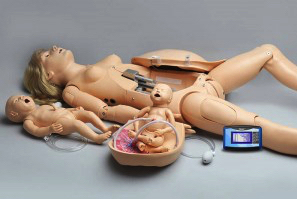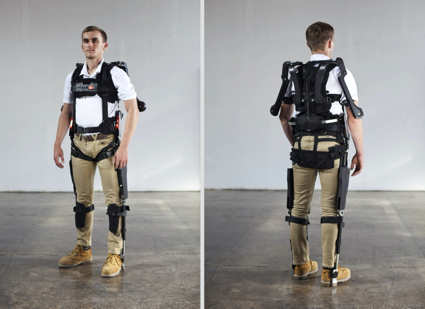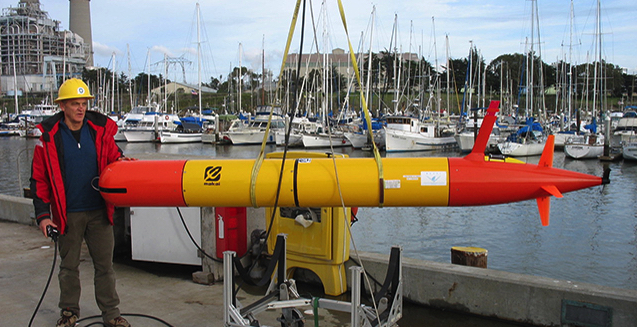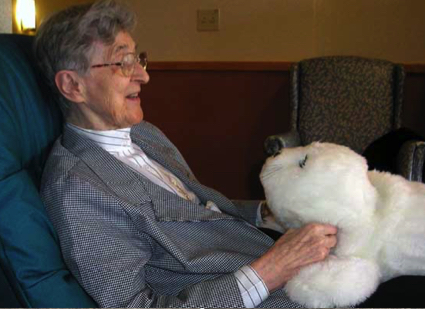by Gary Koerzendorfer
I’ve been mentoring High School robotics for 16 years, and here are some interesting robots I’ve come across. I use these as examples and inspiration for my students.
 Obstetric Simulators “Victoria” and “Noelle”, from Gaumard Scientific, are instrumented robots, used for training medical personnel in the treatment of “early pregnancy complications, high-risk deliveries, and postpartum emergencies” in much the same way as pilots are trained to handle emergencies in a flight simulator.
Obstetric Simulators “Victoria” and “Noelle”, from Gaumard Scientific, are instrumented robots, used for training medical personnel in the treatment of “early pregnancy complications, high-risk deliveries, and postpartum emergencies” in much the same way as pilots are trained to handle emergencies in a flight simulator.
They can accurately simulate a number of risky conditions, as well as leak fluids (mention of which brings a collective “ewww” from my students.)
When people think of robots, science fiction comes to mind – robots in the form of humans. With rapid advances in the field of robotics and AI, there’s no longer a concise definition of “robot” – my high school students build and operate radio-controlled robots, but is a simple radio-controlled model car a robot? We now generally think of a “robot” as a device with programming and capable of complex activities.
Self-driving cars: By this definition, self-driving cars are robots. The topic of self-driving cars expands beyond the technical, bringing (fraught with?) legal, ethical, and societal aspects that are complex and still evolving.
 At the other end of the size spectrum, the Harvard Microbotics Laboratory is researching a “RoboBee” with flapping wings, half the size of a paper clip and weighing tenth of a gram, used for research, and possibly someday for environmental monitoring, search-and-rescue, and even artificial pollination. Video: https://vimeo.com/65313515
At the other end of the size spectrum, the Harvard Microbotics Laboratory is researching a “RoboBee” with flapping wings, half the size of a paper clip and weighing tenth of a gram, used for research, and possibly someday for environmental monitoring, search-and-rescue, and even artificial pollination. Video: https://vimeo.com/65313515
Boston Dynamics is a pioneering robotics firm – you might have seen the video of their doglike robot opening a door: https://youtu.be/fUyU3lKzoio “Spot” is intended for “performing remote data collection and light manipulation in construction sites; monitoring sensors and infrastructure at oil and gas sites; and carrying out dangerous missions such as bomb disposal and hazmat inspections. There are also other promising areas such as security, package delivery, and even entertainment.” The Massachusetts state police are testing a Spot as a “mobile remote observation device” The company is evasive about price.
Do a search for “evolution of Boston Dynamics 2012-2019”, https://youtu.be/NR32ULxbjYc, for videos of their impressive, and sometimes creepy, line of robots. “Big Dog”, the robot shown stumbling on ice and snow, was intended as a military pack animal, but its gasoline engine proved too noisy.
Robots are now commonly used by police for exploration of hazardous areas and bomb disposal. One such robot has been weaponized; In 2016, after a five hour standoff with a sniper who had killed or injured twelve Dallas police officers, the sniper was killed by an explosive carried by the police robot.
 You may have seen surveillance robots at Stanford Shopping Center, or Valley Fair Shopping Center in the south bay. Mountain View company Knightscope makes autonomous robots that slowly roam, sending audio and video to security personnel. (Stanford Shopping Center stopped operating their robot after it knocked over a child.) Knightscope has announced that their robots now include facial recognition capability, for use as their customers see fit. A Knightscope robot in Washingon DC gained notoriety in 2017 by falling down steps into a fountain: https://time.com/4862263/security-robot-fountain-knightscope-k5/
You may have seen surveillance robots at Stanford Shopping Center, or Valley Fair Shopping Center in the south bay. Mountain View company Knightscope makes autonomous robots that slowly roam, sending audio and video to security personnel. (Stanford Shopping Center stopped operating their robot after it knocked over a child.) Knightscope has announced that their robots now include facial recognition capability, for use as their customers see fit. A Knightscope robot in Washingon DC gained notoriety in 2017 by falling down steps into a fountain: https://time.com/4862263/security-robot-fountain-knightscope-k5/
 Several manufacturers have developed powered exoskeletons, mechanical frames worn by people who have lost use of their legs. Their adoption is limited by cost – tens of thousands of dollars, and limited battery life.
Several manufacturers have developed powered exoskeletons, mechanical frames worn by people who have lost use of their legs. Their adoption is limited by cost – tens of thousands of dollars, and limited battery life.
 The Monterey Bay Aquarium Research Institute in Moss Landing, operates oceanographic robots, to map, and collect water and samples of sea life. MBARI operates both tethered (powered and controlled by cables to a surface ship) and AI-controlled autonomous robots.
The Monterey Bay Aquarium Research Institute in Moss Landing, operates oceanographic robots, to map, and collect water and samples of sea life. MBARI operates both tethered (powered and controlled by cables to a surface ship) and AI-controlled autonomous robots.
MBARI has an annual open house, which I highly recommend.
 Paro, a “companionship robot” resembling a baby harp seal, has motors and audio and tactile sensors, and can seek out eye contact, respond to touch, cuddle, remember faces, and learn from peoples’ responses. It’s used to calm and provide therapy for dementia patients,and has been shown to calm, engage, and socialize autistic children.
Paro, a “companionship robot” resembling a baby harp seal, has motors and audio and tactile sensors, and can seek out eye contact, respond to touch, cuddle, remember faces, and learn from peoples’ responses. It’s used to calm and provide therapy for dementia patients,and has been shown to calm, engage, and socialize autistic children.
I try to bring a high-school robotics team to RGs and AGs, please look for us at the next ones!
